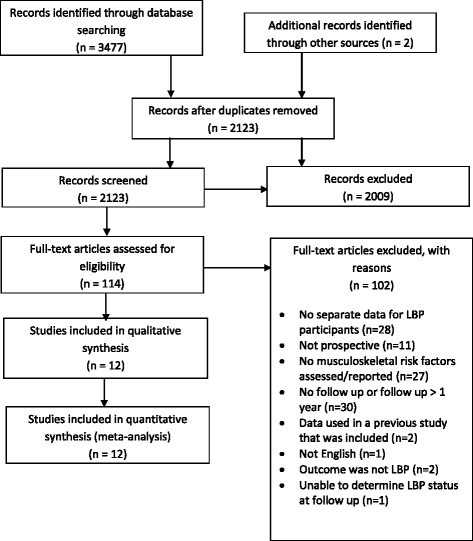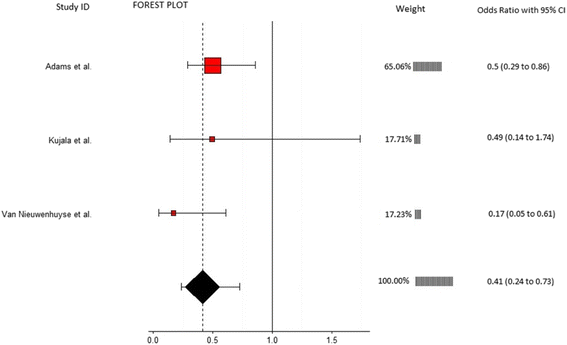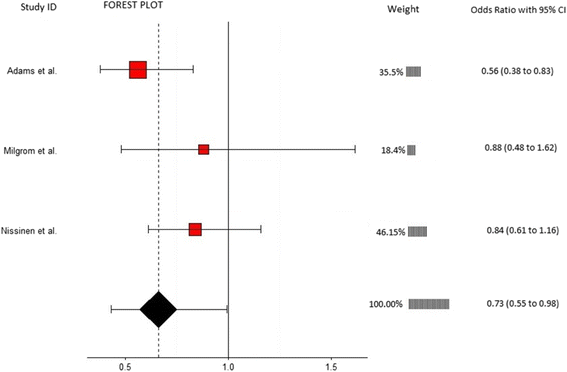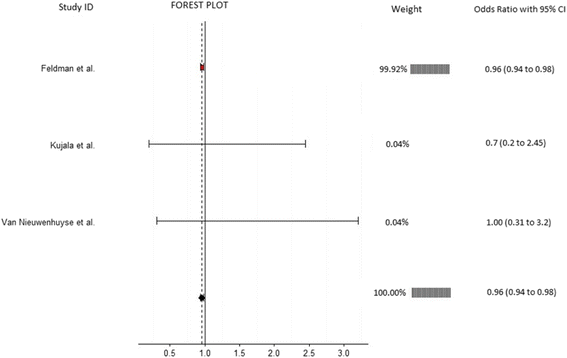Restriction in lateral bending range of motion, lumbar lordosis, and hamstring flexibility predicts the development of low back pain: a systematic review of prospective cohort studies
- PMID: 28476110
- PMCID: PMC5418732
- DOI: 10.1186/s12891-017-1534-0
Restriction in lateral bending range of motion, lumbar lordosis, and hamstring flexibility predicts the development of low back pain: a systematic review of prospective cohort studies
Abstract
Background: Low back pain (LBP) is an increasingly common condition worldwide with significant costs associated with its management. Identification of musculoskeletal risk factors that can be treated clinically before the development of LBP could reduce costs and improve the quality of life of individuals. Therefore the aim was to systematically review prospective cohort studies investigating lower back and / or lower limb musculoskeletal risk factors in the development of LBP.
Methods: MEDLINE, EMBASE, AMED, CINAHL, SPORTDiscus, and the Cochrane Library were searched from inception to February 2016. No age, gender or occupational restrictions of participants were applied. Articles had to be published in English and have a 12 month follow-up period. Musculoskeletal risk factors were defined as any osseous, ligamentous, or muscular structure that was quantifiably measured at baseline. Studies were excluded if participants were pregnant, diagnosed with cancer, or had previous low back surgery. Two authors independently reviewed and selected relevant articles. Methodological quality was evaluated independently by two reviewers using a generic tool for observational studies.
Results: Twelve articles which evaluated musculoskeletal risk factors for the development of low back pain in 5459 participants were included. Individual meta-analyses were conducted based on risk factors common between studies. Meta-analysis revealed that reduced lateral flexion range of motion (OR = 0.41, 95% CI 0.24-0.73, p = 0.002), limited lumbar lordosis (OR = 0.73, 95% CI 0.55-0.98, p = 0.034), and restricted hamstring range of motion (OR = 0.96, 95% CI 0.94-0.98, p = 0.001) were significantly associated with the development of low back pain. Meta-analyses on lumbar extension range of motion, quadriceps flexibility, fingertip to floor distance, lumbar flexion range of motion, back muscle strength, back muscle endurance, abdominal strength, erector spinae cross sectional area, and quadratus lumborum cross sectional area showed non-significant results.
Conclusion: In summary, we found that a restriction in lateral flexion and hamstring range of motion as well as limited lumbar lordosis were associated with an increased risk of developing LBP. Future research should aim to measure additional lower limb musculoskeletal risk factors, have follow up periods of 6-12 months, adopt a standardised definition of LBP, and only include participants who have no history of LBP.
Keywords: Low back pain; Meta-analysis; Prospective cohort studies; Risk factors; Systematic review.
Figures
References
-
- Vos T, Barber RM, Bell B, Bertozzi-Villa A, Biryukov S, Bolliger I, Charlson F, Davis A, Degenhardt L, Dicker D, et al. Global, regional, and national incidence, prevalence, and years lived with disability for 301 acute and chronic diseases and injuries in 188 countries, 1990-2013, a systematic analysis for the Global Burden of Disease Study 2013. Lancet. 2013;386(9995):743–800. doi: 10.1016/S0140-6736(15)60692-4. - DOI - PMC - PubMed
-
- Airaksinen O, Brox JI, Cedraschi C, Hildebrandt J, Klaber-Moffett J, Kovacs F, Mannion AF, Reis S, Staal JB, Ursin H, et al. Chapter 4. European guidelines for the management of chronic nonspecific low back pain. Eur Spine J. 2006;15(Suppl 2):192–300. doi: 10.1007/s00586-006-1072-1. - DOI - PMC - PubMed
Publication types
MeSH terms
LinkOut - more resources
Full Text Sources
Other Literature Sources
Medical
Miscellaneous





